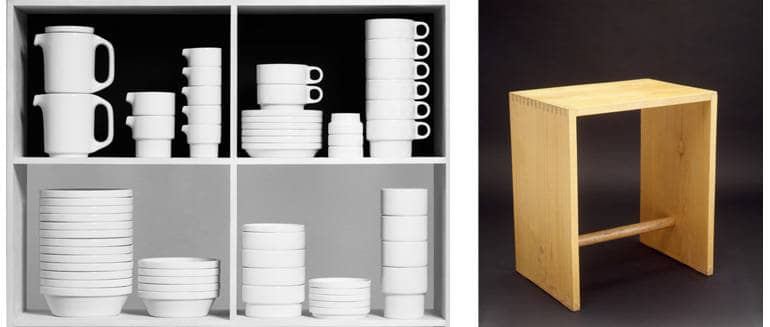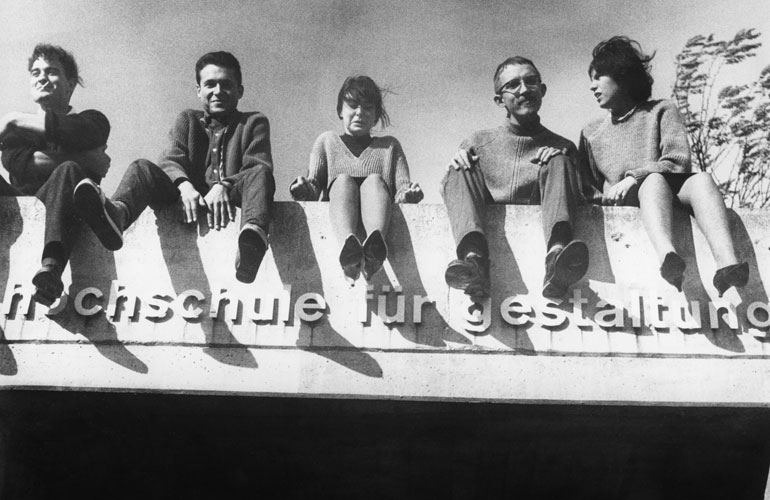HfG - college for design
Opening

© Museum Ulm/ HfG-Archiv
On the day when „ulm“ began to take hold in Ulm, usual conventions lost their capitalization along with the written words, especially concerning dress codes. Thus the guests of cultural and political standing made their way to the festivities at the Ulm Kuhberg in normal street wear, as expressively stated in the invitations: The occasion on this Oct. 1st 1955 was the opening of the college for design, buildings designed by Max Bill. At the same time the college took up its official business.
An international enclave in post-war Ulm. Lecturers as well as students came from all over the world, united by their search for functionality and their use of low case character writing. Soon to become a trademark, their “ulm” today is a symbol for a phase in the history of design connecting industrial production processes with the aesthetics of a technological culture in a radically determined fashion.
The first concepts developed in the Ulm School of thought – closely bound to the Scholl Foundation reach back to 1947. They originate with Inge Scholl and a circle of intellectuals within the periphery of the adult education college founded by her. The first intentions called for the foundation of a “Scholl College” to form a “democratic elite” in order to “counterbalance the resurfacing nationalistic and reactionary forces” which – according to the Scholl circle’s observations – had already begun to take over key positions again.
Inge Scholl established contact to American high commissioner John Mccloy and actually achieved a promise for one million DM in 1950 provided she would be able to find the other half through German sponsors. However, the handover of the check was unexpectedly delayed in 1951; an Ulm editor and former Gestapo member had plotted against the founding members denunciating them as suspected communists. It took a full year until the legendarily determined Inge Scholl was able to placate the suspicious US authorities.
.jpg?h=778&w=770&la=en&hash=3B4E63ED8664BF83A2865523A6C44D97)
© Museum Ulm/ HfG-Archiv
Ulmer Hocker (1954), entworfen von Max Bill, Hans Gugelot, Paul Hildinger.
The college’s intentions changed after Max Bill, Swiss sculpture artist, painter, architect and publisher took part in the planning process on request of Inge Scholl. Bill retracted the current program and created a new concept in April 1950 together with Inge Scholl: “We observe art as the highest expression of life and we intend to establish life as a piece of art. We want to fight ugliness with the help of beauty, goodness and practicality.
”The college started up in 1953 with Bauhaus disciples in the lecturing pool such as Josef Albers, Helene Nonné-Schmidt and Walter Peterhans. They saw themselves absolutely within the Bauhaus tradition, whose founding director Walter Gropius held the opening speech two years later.
Bill, a Bauhaus disciple himself, had the vision to update the ideas of this institution, which still offered free painting classes and was closed by the Nazi Regime in 1933. He wanted to increase the focus on object design. Political professions disappeared from the curriculum, however, a strong socio-political orientation remained, adding to the unique character of the college.

© Museum Ulm/ HfG-Archiv
Tanksäulen (1964/65)
HfG had
four departments. Visual communication and the largest, product design, had the
most effect. The former primarily developed information systems and their
theoretical bases, f. i. graphical corporate identities for companies and
administrations or advertising equipment with machines.
The
latter department saw the creation of objects for daily and production use such
as concepts or studies for furniture, an electric razor, a gas pump and even a
car. Stacking dishes for hotels, a diploma subject by Hans Roericht in 1958/59
are a perfect example for the creative application of mathematic and systematic
thought. The author used only two shapes: the vertical double cylinder and a
floor to wall angle of app. 120 degrees, which is repeated on handles or
spouts.
Much
attention was paid already in the mid fifties to the phono devices by lecturer
Hans Gugelot for the Braun company. They stood in strict contrast to the usual
furniture look-alikes of the times and were the origin of HFG’s early glory.
However,
individual designs were not the main focus. Central interest was placed on
complex solutions as for example the traffic phenomenon. Interdisciplinary
studies – a specific HfG feature – carried out encompassing analyses: starting
with the carriages all the way to schedules, from bus stop design to ticket
machines. “ulm” includes the system principle as much as an attitude of
permanent rethinking.
The
second largest department – construction – was mainly concerned with
industrially prefabricated construction elements. The information department,
the smallest – integrated in 1965 into the institute for film design – analyzed
the language methods of mass information, mass media and the journalistic profession.
The intended study course for city planning was not realized.
.jpg?h=649&w=770&la=en&hash=D02D6D00F59CDA78C91815314E159798)
© Museum Ulm/ HfG-Archiv
Tomás Maldonado im Unterricht, 1958
But how
did all this fit into the concept of free art? Not at all, according to
influential younger lecturers such as Otl Aicher, Tomas Maldonado, Walter
Zeischegg or Hans Gugelot who soon found themselves in direct contradiction of
Bill’s ideas. He left the college in 1957 in an atmosphere of quarrel and
dispute. Otl Aicher wrote: “the ulm model is created: a model of design based
upon technology and science, the designer no longer seen as an artist placed
above and outside but an equal partner in the decision process of an industrial
production.
“HfG members became pioneers concerning fundamental research, theory and
methods. Thus today’s professional designer profile was formed. There was no
longer any room for the independent artist designer.
.jpg?h=679&w=770&la=en&hash=B4A45D49B8A198DB9121E9BFF31E34DE)
© Wolfgang Siol, Ulmer Museum/ HfG-Archiv
Das Logo der Deutschen Lufthansa - ein aufsteigender Kranich - wurde 1962 an der HfG entworfen.
In a large part, HfG owes the wide spreading of the Ulm ideas to the careers of it’s members. An amazing number, estimated at 160, gained professorships within Germany and internationally, many opened their own businesses. Quite a few products developed at HfG have influenced international design. Long after the closing of the college former “ulm” disciples were considered authorities on good design in Germany. The striving for sustainable goods, in itself already containing the ecological train of thought, was an expression of the will to take social responsibility. Even though part of the program explicitly renounced design as an aspect of style, HfG actually did create style. Products were liberated from all “unnecessary” ballast.
Bill’s college building with regular façade elements is a symbol of these principles: “raw and smooth cement, gray, heavy, brutal; then you enter: inside the cement structure remains visible as well, the brick walls in brilliant whitewash, the lighting in neon with no shadows. The rooms also show white brick walls, gray cement columns, raw wooden structures. Temporary, connected to barbaric nudity and might, ascetic but liberating. Radio commentator Bernhard Rübenach articulated his impression towards the end of the 50ies: “Barbarically materialized ratio”. If even an enlightened contemporary like him experienced his judgment oscillating between estrangement and fascination we may imagine the displeasure and impact upon the traditionalist majority. In the beginning, the aesthetics of ascetics cultivated at HfG were only understood by a small minority as well as a few future and design oriented companies. At the college itself these principles took hold in the work attitude as well as life styles, causing observers to recognize religious analogies.

© Museum Ulm/ HfG-Archiv
Studierende auf der Brüstung der HfG-Terrasse, um 1960
The
campus grounds based on American models as well as the manageable dimensions of
a student body with a total of only 637 students led to an individual
microcosm, a HfG culture: the language, seeming hermetic, was shot through with
scientific codes, clothing preference ran to gray and black existentialism and
the HfG stool, symbol of reduction, was the most popular furniture. Freshmen
had their hair cut short, an event that took on the dimension of an official
initiation rite.
An
aerial picture showing the HfG building in the foreground with a background of
Ulm in the dusk was interpreted again and again as symbolizing the difficult
relations between college and city: crystalline purity in contrast to the
chaotic pulse of city life: here the future, there the past. Actually they
really did not have too much in common, a fact which may have favored the
blooming of mutual resentments.
The student paper “output” passed satirical judgment, “the average Ulm
citizens views the college as a disfigurement of the Kuhberg”. On the other
hand, the HfG was quite pleased with it’s image, as Rübenach wrote: “ Her
stigma is exclusivity, a stigma which is self chosen as much as introduced from
outside.”

© Stadtarchiv Ulm
In contrast to other established colleges Hfg could not rely on a ready concept. In accordance with it’s experimental character the curriculum as well as the constitution underwent constant reviews. Rectorship changed several times, all conditions leading to internal conflicts and crises. Finally a critical mass was reached in 1968 threatening the very existence.
Weakened by the retreat of central personalities such as Otl Aicher and Tomas Maldonado, the foundation facing a tight financial situation, attacks from outside as well as corrosive infighting – especially during the student revolt; HfG actually imploded. It was unable to formulate a fitting strategy against the state, which pressed for nationalization aiming to incorporate HfG into the engineering college (today’s Polytechnic). The final blow to HfG was the inability to provide the finance and organization structure concept demanded by the state government and the refusal of the last rector, Herbert Ohl, to accept a last chance in November of 1968, an affiliation with Stuttgart Technical University.
At this point HfG had long begun to dissolve. The foundation cancelled most employees’ contracts for Sept. 30th 1968, only 50 of 180 enrolled students had returned from summer vacation. A follow up “institute for environmental planning” existed until 1972. The legacy of HfG, as well as the legacies of Aicher, Zeischegg and Gonda are cared for in the HfG archive, founded in 1987 as a department of Ulm Museum.
While loosing its magnetic effect towards the end, HfG began it’s rise into myth. Lecturer Gui Bonsiepe articulated one of these fabrics of myth: “ The disputes about the continuation started prior to the construction of the buildings. Next to the politically motivated rejections, caused by HfG’s decisive anti nazi stand, pure provincial ignorance and culture conservative attitude acted against the institution. Because it does not fit into traditional culture schemes.
”This version of a politically forced ending is supported until this day by a quote (abbreviated) of the president of the state of Baden-Württemberg of the time, Hans Filbinger: “ We wanted to create something new and that requires the liquidation of the old.”

